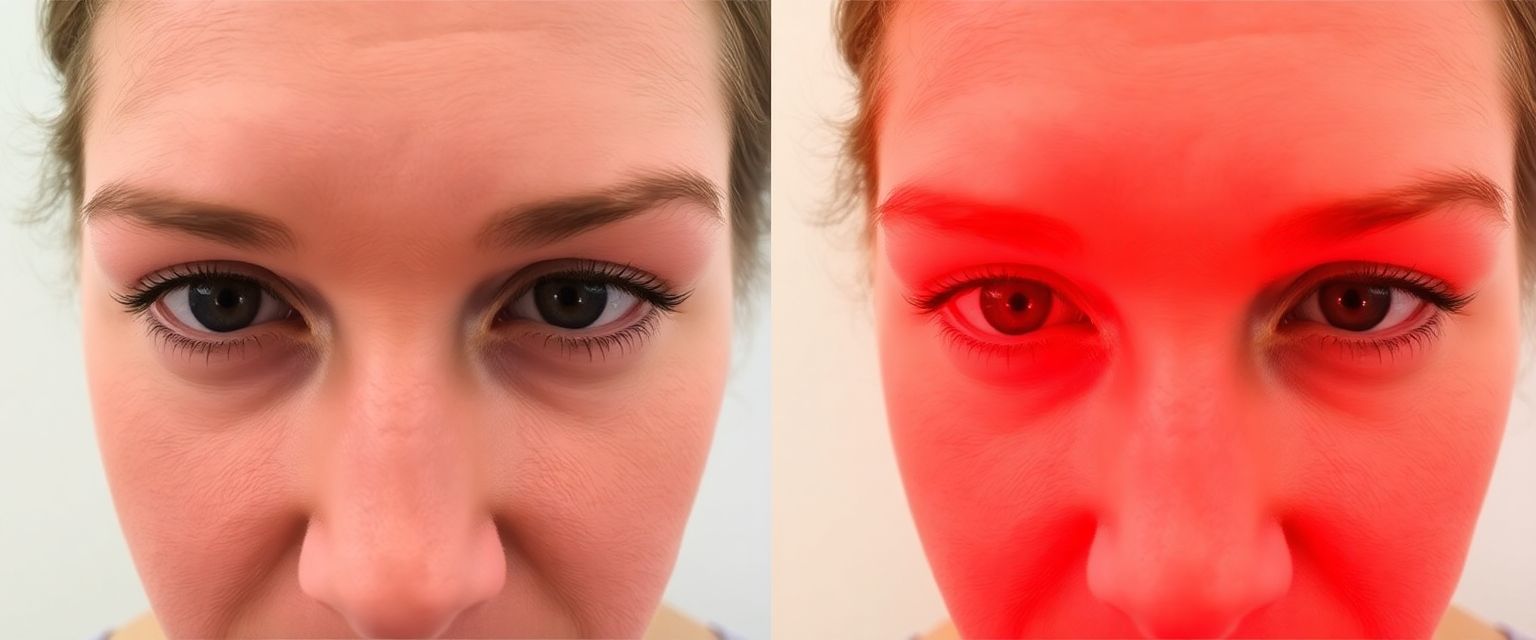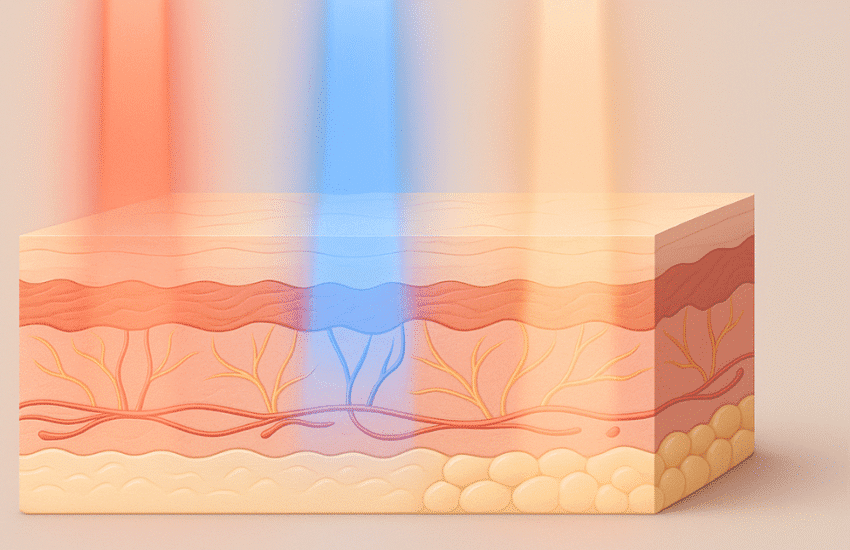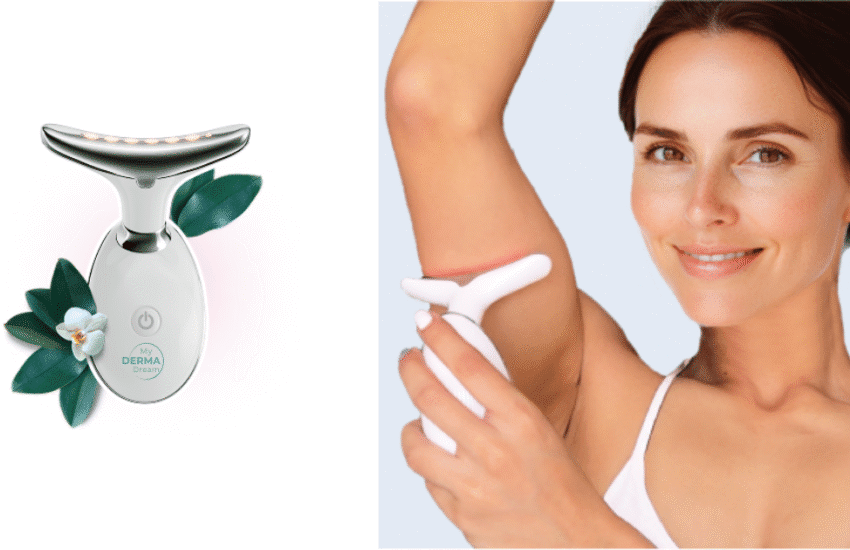Can Red Light Therapy Tighten Skin? Here’s What Science Says
Red light therapy has emerged as a popular skin treatment, with many asking whether red light therapy can tighten skin. Research suggests that red light therapy may improve skin firmness and elasticity by potentially stimulating collagen production and cellular regeneration, though individual results may vary.
Unlike invasive procedures, red light treatments work at the cellular level, using specific wavelengths to penetrate the skin and potentially activate the body’s natural rejuvenation processes. Some users report improved skin tone and tightness after consistent sessions, making it an attractive option for those looking for non-surgical skin firming solutions.
How Red Light Therapy May Work for Skin Tightening & Firmness
Red light therapy utilizes specific wavelengths between 630-700 nanometers that can penetrate deeper than surface treatments. These wavelengths may potentially activate fibroblast cells—the collagen and elastin-producing cells that contribute to skin structure and firmness.
The proposed mechanism involves photobiomodulation, which may trigger cells to produce more ATP, their primary energy source. This in turn, encourages skin cells to increase production of structural proteins. The approach works with the body’s natural processes rather than causing damage that requires repair.
Research demonstrates that low-level red light (640 nm) combined with near-infrared light (830 nm) may increase the expression of genes responsible for collagen and elastin production, including COL1A1, COL3A1, and ELN genes, while also potentially boosting ATP production in human dermal fibroblasts [2]. However, individual responses can vary considerably.
The Science Behind Red Light Therapy and Collagen Production
Skin firmness relies heavily on collagen synthesis, and red light therapy may potentially influence this process. When 633-660nm wavelengths reach the skin, they may activate chromophores—light-sensitive receptors that could influence cellular regeneration.
Some research shows promising results. A controlled trial of 136 volunteers found that red light therapy (611-650 nm wavelengths) appeared to improve intradermal collagen density, with treated subjects showing collagen increases compared to untreated controls after 30 sessions over 15 weeks [1].
This is noteworthy considering the natural collagen loss that occurs—approximately 1% per year after age 20.
The approach works with the body rather than against it, potentially activating the skin’s own collagen pathways and encouraging fibroblast activity that may lead to improvements in skin structure.
Some people may observe changes in elastin production and overall firmness after 8-12 weeks of regular sessions, though this timeline can vary. The process takes time as it may involve rebuilding the skin’s foundation rather than temporarily plumping the surface.
At-Home vs. Professional Red Light Therapy Options
The debate between professional treatments and at-home red light devices often comes down to power and convenience. Professional machines deliver higher energy output—sometimes 10 times stronger than home units—which can accelerate your skin tightening protocol.
Professional sessions typically cost $50-150 each, while quality at-home devices range from $200-500. The investment may be worthwhile for those committed to regular use, though results are not guaranteed.
Home devices may require longer sessions to match professional results. Where a clinic treatment might take 15 minutes, you might need 20-30 minutes at home. But the convenience factor is huge—no appointments, no travel time, just consistent photobiomodulation at home on your schedule.
Some people find success starting with professional treatments to understand what results feel like, then transitioning to home care for maintenance. This approach gives you the best of both worlds.
Combining Red Light Therapy with Other Non-Invasive Approaches
Red light therapy plays remarkably well with other skin firming approaches. When combined with vitamin C serums and peptides, the enhanced cellular activity helps these ingredients work more effectively.
Red light therapy and retinol also complement each other. The light therapy can actually reduce retinol irritation while boosting its collagen-stimulating effects.
For those considering red light therapy alongside microcurrent treatments, both approaches target different aspects—microcurrent can help to tone underlying muscles while red light targets better skin. Just space treatments appropriately to avoid overwhelming your skin.
How Often to Use Red Light Therapy for Skin Tightening
Treatment frequency may influence outcomes. During the initial phase, 3-5 sessions weekly are often suggested to jumpstart collagen production.
Sessions typically last 10-20 minutes depending on your device’s power. The optimal treatment duration varies by skin penetration depth, for example facial skin responds faster than thicker body areas.
After achieving any desired results (usually 8-12 weeks), shifting to maintenance mode may help preserve improvements. Two sessions weekly often suffice to preserve improvements.
Consistency trumps intensity every time. Three gentle sessions weekly beat one marathon session. Your cells need regular stimulation to maintain enhanced cytokine regulation and continued collagen synthesis.
The Science of Wavelengths: Choosing the Right Red Light for Your Skin
Understanding wavelength selection can help to maximize your results. The 630-660nm range targets superficial layers where visible aging often occurs. These wavelengths are better for surface-level improvements and overall skin texture.
Near-infrared wavelengths (810-850nm) penetrate deeper, reaching the dermis where structural proteins form. Combining both ranges—often called red light therapy for skin rejuvenation—addresses multiple skin layers simultaneously.
Some devices offer single wavelengths while others combine multiple options. For comprehensive face tightening, multi-wavelength devices may deliver superior results by targeting different tissue depths.
The scientific evidence for red light therapy skin tightening consistently points to these specific ranges. Cheaper devices using different wavelengths won’t deliver the same cellular response or collagen induction benefits.
How to Create A Personal Red Light Therapy Protocol
Success requires more than just switching on a device. Proper positioning ensures even coverage—hold panels 6-12 inches from skin for optimal penetration. Clean skin absorbs light better than skin covered in heavy creams.
Timing matters too. Some research suggests morning treatments align with natural chronobiology patterns, potentially enhancing results. Others prefer evening sessions as part of their relaxation routine.
Track your progress with photos every 2 weeks. Use consistent lighting and angles to accurately assess changes.
Consider your overall skin health too. Adequate hydration, proper nutrition, and sun protection all support your skin’s ability to respond to light therapy. Think of red light as one powerful tool in your comprehensive approach to skin health.
Conclusion
Red light therapy offers a scientifically-backed, gentle approach that may improve skin firmness and reduce signs of aging. Through consistent application of specific wavelengths, it may potentially stimulate the body’s natural collagen and elastin production processes, which could lead to improved skin appearance.
The key to success lies in understanding that this is a gradual process requiring commitment. Whether you choose professional treatments or invest in an at-home device, regular sessions over 8-12 weeks typically yield the most noticeable improvements in skin structure and elasticity.
While red light therapy won’t replicate surgical results, it provides a no-downtime option that works harmoniously with your skin’s natural regenerative processes. For many people looking to address mild to moderate skin laxity, maintain results from other treatments, or take preventative measures against future sagging, it represents a useful addition to their skincare arsenal.
As with any skin treatment, individual results vary significantly, so consulting with a skincare professional can help determine if red light therapy aligns with specific skin goals and expectations.
References
- Wunsch A, Matuschka K. A Controlled Trial to Determine the Efficacy of Red and Near-Infrared Light Treatment in Patient Satisfaction, Reduction of Fine Lines, Wrinkles, Skin Roughness, and Intradermal Collagen Density Increase. Photomed Laser Surg. 2014 Feb;32(2):93-100.
- Li WH, Seo I, Kim B, Fassih A, Southall MD, Parsa R. Low-level red plus near infrared lights combination induces expressions of collagen and elastin in human skin in vitro. Int J Cosmet Sci. 2021 Jun;43(3):311-320.


